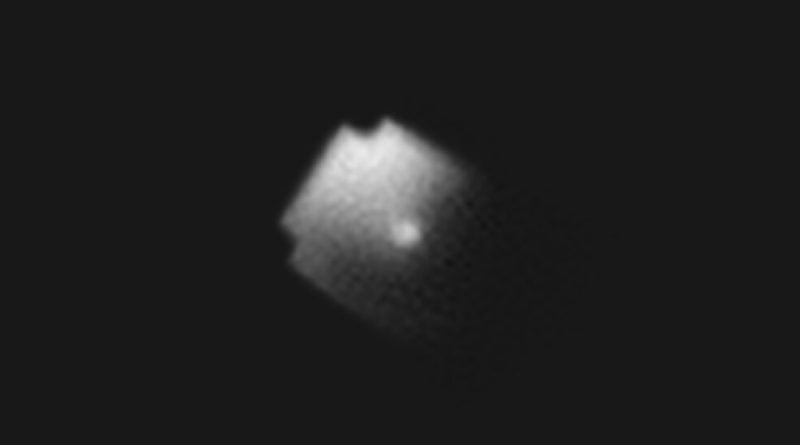A New Satellite Outshines Some of the Brightest Stars in the Sky
[ad_1]
Last November, a satellite in low-Earth orbit unfurled into an expansive array that extends across nearly 700 square feet, about the size of a studio apartment.
The satellite, BlueWalker 3, has since become one of the brightest objects in the sky, outshining some of the most radiant stars in the Milky Way, according to a study published on Monday in Nature — and it is just the first of dozens of similar satellites that are in development by AST SpaceMobile, a company that aims to keep smartphones connected from orbit.
Astronomers were already worried about the emergence of satellite megaconstellations, such as SpaceX’s Starlink, which have shiny surfaces that at times interfere with views of space from the ground. The launch and deployment of BlueWalker 3 have compounded those concerns.
“The issue is not necessarily that one satellite,” said Siegfried Eggl, an astrophysicist at the University of Illinois, Urbana-Champaign and an author of the new study, “but that it is a predecessor or prototype of a constellation, so there’s going to be a lot of those out there eventually.”
Initially launched in September 2022, BlueWalker 3 is the forerunner of AST SpaceMobile’s BlueBird satellites, which aim to serve as a network of orbital cell towers with the goal “to democratize access to knowledge and information regardless of where people live and work,” a spokesperson for AST SpaceMobile said. Last month, BlueWalker 3 successfully relayed its first 5G connection to a smartphone in a cellular coverage gap on Earth.
AST SpaceMobile is one of many companies racing to capture the surging demand for global broadband connectivity. SpaceX has launched about 5,000 satellites into space as part of its Starlink network, which already provides satellite internet service to customers around the world. Other companies, such as Amazon (which is scheduled to launch its first prototype satellites on Friday) and OneWeb, have similar ambitions, and many countries are developing their own communications megaconstellations.
“At the moment, there are 18 constellations that we know are planned all over the world,” Dr. Eggl said. “The total number of satellites is a stunning half a million that people are planning to put up there. This is 100 times more than we already have.”
The rapid proliferation of satellites in recent years has alarmed stargazers from all walks of life. As spacecraft move across the sky, they create bright trails and an ambient glow in the sky that can destroy astronomical images and obscure fainter celestial objects that would otherwise be visible to the naked eye.
“It’s going to be a major change with these constellations,” said Jeremy Tregloan-Reed, an astronomer at the Universidad de Atacama in Chile and an author of the study.
AST SpaceMobile made BlueWalker 3’s array so large in order to beam strong cellular coverage directly to phones on Earth. The satellite is made of many small antennas that can connect existing smartphones, which is an approach that distinguishes the company from Starlink and other planned constellations that currently rely on ground antennas or dishes.
To find the specific impact of BlueWalker 3, the authors of the new study compiled observations of the satellite recorded by amateur and professional astronomers in Chile, the United States, Mexico, New Zealand, the Netherlands and Morocco. This global campaign revealed that BlueWalker 3 reached a magnitude that made it as bright as Procyon and Achernar, two of the 10 most luminous stars in the sky, according to the study.
“I really like how they used many different telescopes from many different places in the world; it highlights how this is truly a global problem,” said Samantha Lawler, an astronomer at the University of Regina in Saskatchewan who was not involved with the study but wrote an article in Nature that accompanied it. “One country, or one small company, launches a satellite and it can be seen everywhere in the world.”
AST SpaceMobile said that it was working with astronomers on techniques to reduce disruptions. It also contrasted the number in its constellation with the tens of thousands planned by other companies. The spokesperson said it could “provide substantial global coverage with around 90 satellites.”
Though BlueBird satellites would be far fewer in number, they are at least 64 times as big and bright as a Starlink satellite. The SpaceX orbiters are also brightest in the days after their deployment, but they become much fainter once they settle into their target orbits.
Astronomers expect that the BlueBird satellites will remain bright in the sky throughout most of their lifetime. As a consequence, one of these satellites could interfere with data captured by astronomical observatories.
“They are so bright that they will ruin entire images that are recorded with large-scale telescopes, such as the Vera Rubin Observatory, for instance,” Dr. Eggl said.
There are currently no regulations that prevent companies from launching bright and voluminous satellite constellations, though many scientists and dark sky advocates, including Indigenous rights groups, are making the case for rules. And even as many companies make efforts to darken their satellites, they continue launching them at a breakneck pace.
“We shouldn’t have progress at any cost,” Dr. Tregloan-Reed said. “It’s like building a brand-new development over a historical site. You can’t just do that. You have to protect these things. ”
He also acknowledged that astronomers don’t own the night sky but have a vested interest in preserving it.
“What we’d like to do is share the night sky and get the public to understand that this is a potential issue,” he said.
